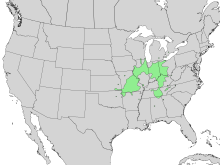Fraxinus quadrangulata
| Blue ash | |
|---|---|
| | |
| Scientific classification | |
| Kingdom: | Plantae |
| Clade: | Angiosperms |
| Clade: | Eudicots |
| Clade: | Asterids |
| Order: | Lamiales |
| Family: | Oleaceae |
| Genus: | Fraxinus |
| Section: | Fraxinus sect. Dipetalae |
| Species: | F. quadrangulata |
| Binomial name | |
| Fraxinus quadrangulata Michx. | |
 | |
| Natural range of Fraxinus quadrangulata | |
 | |
| Close-up of natural range of Fraxinus quadrangulata | |
Fraxinus quadrangulata, the blue ash, is a species of ash native primarily to the Midwestern United States from Oklahoma to Michigan, as well as the Bluegrass region of Kentucky and the Nashville Basin region of Tennessee. Isolated populations exist in Alabama, Southern Ontario, and small sections of the Appalachian Mountains.[1] It is typically found over calcareous substrates such as limestone, growing on limestone slopes and in moist valley soils, at elevations of 120–600 m.[2][3]
Description
Blue ash is a medium-sized deciduous tree typically reaching a height of 10–25 m with a trunk 50–100 cm diameter. The twigs typically have four corky ridges, a distinctive feature giving them a square appearance (in cross-section), hence the species name, quadrangulata, meaning four-angled. The winter buds are reddish brown. The leaves are 20–38 cm long, with 5–11 (most often 7) leaflets, the leaflets 7–13 cm long and 2.5–5 cm broad, with a coarsely serrated margin and short but distinct petiolules. The flowers are small and purplish, produced in the early spring before the leaves appear. The fruit is a samara 2.5–5 cm long and 6–12 mm broad, including the wing.[2][3]
History and uses
The name blue ash is derived from the black dye extracted from the tree's inner bark through immersion in water. European colonists and American pioneers used this dye to color yarn for use in the production of textiles, sewing, crocheting, knitting, weaving, and embroidery. Blue Ash wood is used to make flooring, baseball bats, furniture, tool handles, crates and barrels.[3] The city of Blue Ash, Ohio, an inner suburb of Cincinnati, drew its name from the blue ash trees in the area, the logs of which were used to build many of the community's earliest buildings.[4]
Conservation status
As of 2014, blue ash appears to be least threatened in comparison to other North American ash by the infestation of the emerald ash borer. First detected in North America in 2002, this invasive beetle has since spread throughout much of this tree's range. Approximately sixty to seventy percent of these trees survive[5] compared to other ash such as black ash and green ash where up to ninety-nine percent of them are killed by emerald ash borer.
References
- ↑ "Fraxinus Quadragulata Range Map" (PDF). United States Geological Survey. Retrieved 2008-03-02.
- 1 2 Virtual Herbarium of the Chicago Region: Fraxinus quadrangulata
- 1 2 3 Oklahoma Biological Survey: Fraxinus quadrangulata
- ↑ "Brief History of Blue Ash". City of Blue Ash, Ohio.
- ↑ Tanis, S. R.; McCullough, D. G. (25 July 2012). "Differential persistence of blue ash and white ash following emerald ash borer invasion". Canadian Journal of Forest Research. 42 (8): 1542–1550. doi:10.1139/x2012-103.